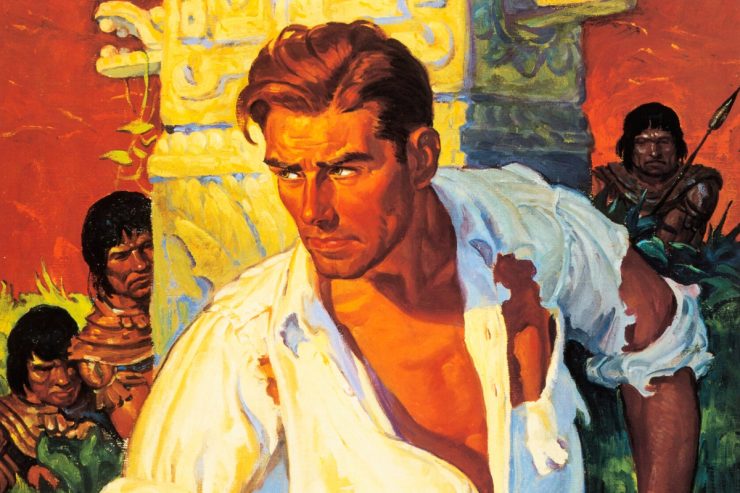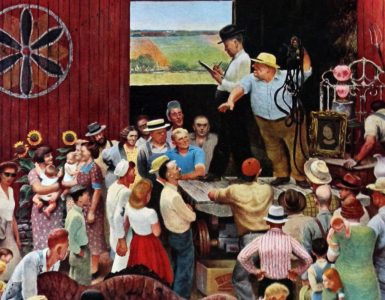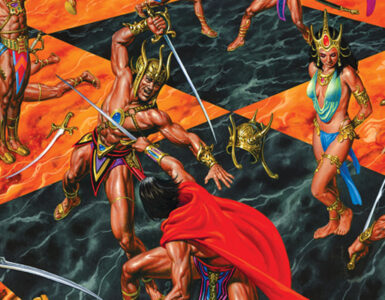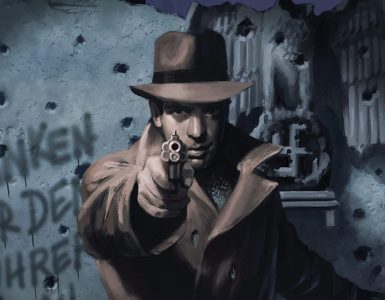Pulp magazines have not only influenced writers, artists, film directors, software developers, and countless others over the years. They’ve influenced pulp fans as well. This month our “PulpFest Profile” focuses on the longtime guiding light of Pulpcon, the first gathering specifically geared toward pulp fiction and art and the magazines in which they appeared.

It’s hard to believe in this age when there are several annual pulp conventions spread across North America, that fifty years ago, there were no organized gatherings specifically geared toward pulp fiction and the magazines in which it appeared. But that was the case when three St. Louis pulp fans — Ed Kessell, Earl Kussman, and Nils Hardin — teamed up and founded Pulpcon.
After consulting with longtime science-fiction fan, James “Rusty” Hevelin, Kessell took the lead and began to organize what was planned as a one-shot convention. Adopting the name Pulpcon and advertising in the leading pop culture fanzines of the day, Kessell and his cohorts were able to attract about one-hundred pulp fans to the Colony Motor Hotel in Clayton, Missouri over a June weekend in 1972.
With science-fiction writers Leigh Brackett and Edmond Hamilton and pulp magazine cover artist Graves Gladney in attendance, the first Pulpcon was a rousing success. As the convention was drawing to a close, people began to ask for an encore. And so was born the first convention meant to specifically honor pulp magazines.
Don Hutchison — widely recognized as a leading authority on the history of the pulp fiction era — reports that after Kessell suggested that he wasn’t interested in organizing an annual convention, “Rusty Hevelin, Lynn Hickman, and Gordon Huber stepped up to the plate to prevent the initial Pulpcon from being a one-shot effort. After this, Rusty would assume the helm as the guiding force to run Pulpcon for over thirty years.”
All told, a total of thirty-nine Pulpcon conferences took place. The last one was held in Dayton, Ohio in August 2008. Shortly thereafter, PulpFest was founded.
 According to Hutchison, “Rusty was born February 16, 1922, and grew up in Riverside, California, where he became addicted to reading (and collecting) pulp magazines. Like many young people of the time, he was entranced by the burgeoning science fiction titles as well as being inspired by the heroic exploits of Doc Savage and his roistering crew.
According to Hutchison, “Rusty was born February 16, 1922, and grew up in Riverside, California, where he became addicted to reading (and collecting) pulp magazines. Like many young people of the time, he was entranced by the burgeoning science fiction titles as well as being inspired by the heroic exploits of Doc Savage and his roistering crew.
“He went to a meeting of the Los Angeles Science Fiction Society in 1941 and attended the third-ever Worldcon that same year. He became a dedicated SF fan and would remain so for the rest of his life, earning him the unofficial title of ‘walking encyclopedia of fandom.’
“Rusty was a fanzine publisher and contributor, convention host and panelist, book collector and dealer, and a friendly and generous presence at literally hundreds of conventions over the years. It seems as if he had the knack of discovering newcomers to the hobby of fandom and making them welcome at such events.
“Everybody has a story about their first meeting with Rusty. Mine occurred at the NyCon 3 World Science Fiction Convention in New York City in 1967. Rusty and I had corresponded but never met. When we did actually get together he immediately took my wife, Jean, and me under his wing and went about introducing us to his many famous fan friends and authors. It was a great convention for us, thanks to Rusty.”
John Wooley, the winner of the 2006 Lamont Award, remembers his first encounter with Rusty Hevelin in another way:
“For the life of me, I can’t recall whether it was 1989 or 1990 that Jim Millaway and I, intrigued by what we’d been reading in the pages of pulp fanzines, headed out from Tulsa to Dayton to attend our very first Pulpcon. I do remember, however, the white-bearded ringmaster in the faded t-shirt, who welcomed us into what felt like nothing less than a magical secret society.”
A veteran of the Second World War — serving in the US Marines in the South Pacific — Hevelin was an active participant in science fiction fandom for most of his adult life. After moving to Philadelphia in 1941, Hevelin joined the Philadelphia Science Fiction Society, one of the oldest science fiction clubs in existence. He was soon elected the president of the organization. Later, he served as a director of the National Fantasy Fan Federation, also known as N3F. A member of the Pulp Era Amateur Press Society (PEAPS), he was a prominent fanzine publisher, most notably Aliquot, Badly, Fantascience Digest, H-1661, and Nebula, a mimeographed news zine subtitled “The Fantasy Fan Record.”
 Rusty was also a notable collector of fanzines. According to his dear friend and fellow fan, Bob Tucker (who wrote science fiction as Wilson Tucker), Rusty had “a houseful of books, magazines, and fanzines — literally a houseful, because he is a packrat and takes home with him every issue of Weird Tales or Astounding Stories that he can find. His collection goes back to the true golden age of science fiction when Hugo Gernsback was an apprentice and Harry Bates a schoolboy. He also saves string.”
Rusty was also a notable collector of fanzines. According to his dear friend and fellow fan, Bob Tucker (who wrote science fiction as Wilson Tucker), Rusty had “a houseful of books, magazines, and fanzines — literally a houseful, because he is a packrat and takes home with him every issue of Weird Tales or Astounding Stories that he can find. His collection goes back to the true golden age of science fiction when Hugo Gernsback was an apprentice and Harry Bates a schoolboy. He also saves string.”
Rusty’s fanzine collection is being digitized by the University of Iowa Libraries.
According to the 2013 Munsey Award winner, Garyn Roberts, “Rusty Hevelin was living pulp magazine history. He was a good man and a good friend who liked and collected everything pulp and pulp-related. . . . It is hard to think that Rusty would be 100 this month. This means that he lived through much of the Golden Age of the pulpwood magazine. He was a pioneer, a celebrant, scholar, and preserver of those story periodicals which so many of us cherish. He would have made a great pulp fiction character himself.”
Editor, critic, and author Gary K. Wolf “. . . came to realize that Rusty was an acute reader, with a sharp critical mind belied by his resonant cowboy drawl. He not only kept up with much current fiction but brought to it something like six decades of reading SF as it appeared to the fans of the era. He knew Heinlein and Asimov and everyone else, of course, but he also remembered what it was like to discover their work when they were first being published (and to meet Heinlein as a fellow fan at the 1941 Denver Worldcon). The ways in which SF was read and received by its contemporary fans are a part of literary history too easily lost to critics and historians, and Rusty was the embodiment of that reading history.”
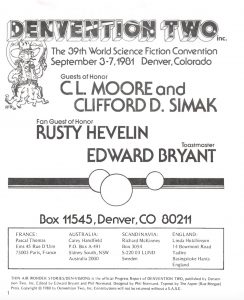 The Fan Guest of Honor at the 1981 Worldcon — Denvention Two — Hevelin served on many panels concerning the history of fandom and fanzines. With his close friend, Gay Haldeman, he often helped new fans by presenting “How to Enjoy Your First Convention” or “So: This Is Your First Convention? Here’s What To Expect.” In 1992, Rusty interviewed Frank Robinson, Art Widmer, and Al Williamson at the 50th Worldcon, held in Orlando, Florida. All three of these interviews are available through YouTube.
The Fan Guest of Honor at the 1981 Worldcon — Denvention Two — Hevelin served on many panels concerning the history of fandom and fanzines. With his close friend, Gay Haldeman, he often helped new fans by presenting “How to Enjoy Your First Convention” or “So: This Is Your First Convention? Here’s What To Expect.” In 1992, Rusty interviewed Frank Robinson, Art Widmer, and Al Williamson at the 50th Worldcon, held in Orlando, Florida. All three of these interviews are available through YouTube.
Well-known as a huckster, collector, interviewer, and toastmaster in the science fiction and pulp communities, Rusty was the 1986 recipient of the Big Heart Award for service to the science fiction community, the 1986 winner of Pulpcon’s Lamont Award, and the recipient of First Fandom’s 2003 Sam Moskowitz Archive Award for excellence in science fiction collecting. In 2012, he was posthumously added to the First Fandom Hall of Fame. All of those so honored must have contributed for 30 years or more to science fiction fandom.
Rusty’s close friend, science fiction author Joe Haldeman, described Rusty as “a vastly accepting man, with endless patience for the young and foolish (and the old and clueless); everybody’s grandfather figure, but much more fun to be with than your actual grandfather. Many of us loved him, and he loved in return.”
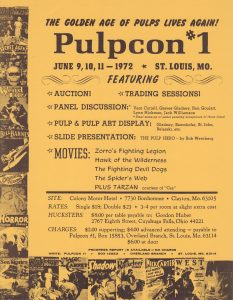 With the help of Lynn Hickman and Gordon Huber — and later, Richard Clear — Rusty Hevelin kept Pulpcon from being a “one-and-done” affair. He served as the convention’s guiding light for over thirty years. Thanks to Rusty’s vision and effort, when PulpFest was founded in late 2008, it was launched on the premise that the pulps had a profound effect on American popular culture. The rough paper magazines reverberated through a wide variety of mediums — comic books, movies, paperbacks and genre fiction, television, men’s adventure magazines, radio drama, and even video, computer, and role-playing games.
With the help of Lynn Hickman and Gordon Huber — and later, Richard Clear — Rusty Hevelin kept Pulpcon from being a “one-and-done” affair. He served as the convention’s guiding light for over thirty years. Thanks to Rusty’s vision and effort, when PulpFest was founded in late 2008, it was launched on the premise that the pulps had a profound effect on American popular culture. The rough paper magazines reverberated through a wide variety of mediums — comic books, movies, paperbacks and genre fiction, television, men’s adventure magazines, radio drama, and even video, computer, and role-playing games.
According to Don Hutchison, Rusty Hevelin’s determination to keep Pulpcon focused on the pulps, produced “a series of model conventions renowned for their friendliness and a dealers’ room so safe that tables could be, and often were, left unattended by room-roving fellow hucksters.” Tony Davis — winner of the 1999 Lamont Award — found Rusty to be “welcoming to new convention attendees and fully dedicated to the preservation of the pulps and pulp fandom.” Rusty Award winner, J. Barry Traylor, thought of Hevelin as “. . . the uncle I never had. He always had time for me as well as interesting information about the pulps.”
Soon after her book Pulp Man’s Odyssey: The Hugh B. Cave Story was published, retired journalist and biographer Audrey Parente was introduced to a “wild-haired biker named Rusty Hevelin.” According to Audrey, “Rusty gave me more credit than I deserved because he assumed that I knew a lot about the pulps given the Cave biography. . . . and also invited me to attend something called Pulpcon to sign books from Starmont House that would be there waiting for me. . . . Rusty said he’d buy the plane ticket, pick me up at the airport, and bed and board would be free at the college in Ohio. . . . When my Theodore Roscoe book was published, he paid for me to come again to Pulpcon. . . . I never got an opportunity to repay his years of kindness and help. Thanks, Rusty.”
In the view of pulp and science fiction fan, collector, writer, and dealer, Curt Phillips, “Rusty did the largely thankless work of keeping pulp fandom focused and helping to teach it that the real point of . . . any fandom isn’t found in moldering stacks of old magazines but is instead found within the other people who recognize and share the interest and passion for the hobby that brought us to the convention in the first place.”
Following the demise of Pulpcon in 2008, Rusty did not attend the first two gatherings of its successor, PulpFest. Then, in the final year of his life, as he entered the PulpFest dealers’ room for the very first time, spontaneous applause broke out, sustained and heartfelt. Afterward, John Wooley spotted Rusty. As he approached, Rusty turned toward Wooley with wonder in his eyes:
“John,” he said. “They clapped for me. They clapped for me.”
According to Wooley, Rusty “acted as though he couldn’t believe it, and maybe he couldn’t. Indeed, maybe his reception could’ve gone another way. But I’ll always be proud of my fellow pulp fans for making it go the right way, for igniting a sense of joy and wonder in a debilitated man, approaching death, who had done so much for us and the art and literature we, and he loved.”
Shortly after the passing of James “Rusty” Hevelin in 2011, PulpFest created the Rusty Hevelin Service Award, named for the man who guided Pulpcon for most of its existence. Designed to recognize those persons who have worked long and hard for the pulp community with little thought for individual recognition, the Rusty is meant to reward It is meant to reward largely quiet and unheralded work and is reserved for those individuals who are most deserving.
PulpFest chairman Jack Cullers who, with his wife Sally, won the first Rusty Hevelin Service Award in 2012, believes that without Rusty’s “input and guidance the convention we know as PulpFest would probably not exist. . . . His love of science fiction and conventions was very important to him. Those of us who still participate in such events owe him a debt of gratitude.”
PulpFest seeks to honor pulp fiction and pulp art by drawing attention to the many ways they have inspired writers, artists, film directors, software developers, game designers, and other creators over the decades.
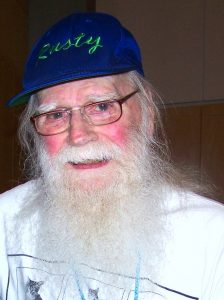 What inspired PulpFest? It was the pulps, of course, but also “. . . the white-bearded ringmaster in the faded t-shirt” and the other visionaries who gave us Pulpcon!
What inspired PulpFest? It was the pulps, of course, but also “. . . the white-bearded ringmaster in the faded t-shirt” and the other visionaries who gave us Pulpcon!
In 2022, PulpFest will celebrate its fiftieth summertime convention. Debuting in 2009, this will be our 13th PulpFest following 37 Pulpcons held each summer between 1972 and 2008. We hope you’ll join us for PulpFest 50, taking place at the beautiful DoubleTree by Hilton Hotel Pittsburgh – Cranberry in Mars, Pennsylvania from August 4 – 7.
You can become a member of PulpFest 50 by clicking the Registration button on our website. If you need lodging, you can also book a room on our page. To learn about this year’s programming, click that button.
Kenneth Grant is a writer and popular culture enthusiast who has volunteered to help the PulpFest organizing committee. He’s looking forward to writing more for our website and The Pulpster.
Don Hutchison’s memories of Rusty can be found in The Pulpster #21, dated August 2012. Bob Tucker’s “Rusty Hevelin, Himself” is from the Denvention Two Program Book from 1981. The impressions of Joe Haldeman and Gary K. Wolf are from Locus for February 2012, published shortly after Rusty Hevelin’s death on December 27, 2011. Curt Phillips’ thoughts are from “Another Fan’s Poison,” a column published in Time and Again #10, dated October 2009. The recollections of John Wooley, Garyn Roberts, Tony Davis, J. Barry Traylor, Audrey Parente, and Jack Cullers were shared with PulpFest in private correspondence.
Our initial photograph of James “Rusty” Hevelin is courtesy of Andy Porter. It was taken at a Boskone in the 1970s, about the time of the founding of Pulpcon. The September 1943 issue of Fan Slants — featuring cover art by Ronald Clyne — is one of the thousands of fanzines in The Hevelin Collection, housed at the University of Iowa Libraries. The Denvention Two advertisement is from Thin Air Wonder Stories/Den-Visions, the official Progress Report One of the 39th World Science Fiction Convention, held in Denver, Colorado in 1981. The artwork is by Phil Normand. The flyer for Pulpcon #1 is from the collection of Michael Chomko. The photograph of the white-bearded Hevelin is by William S. Higgins. It was taken at the 2008 World Science Fiction Convention, Denvention 3.
Although very well-known as a science fiction fan, Hevelin was also a big fan of the hero pulps, particularly Doc Savage Magazine. For many years, he owned Walter M. Baumhofer’s original cover painting for the October 1933 issue of the Street & Smith pulp, illustrating the Lester Dent novel, “The Man of Bronze.”
To hear Rusty Hevelin talk about his relationship with Pulpcon, visit ThePulp.Net for “Rusty Hevelin’s ‘First Final Farewell.”

